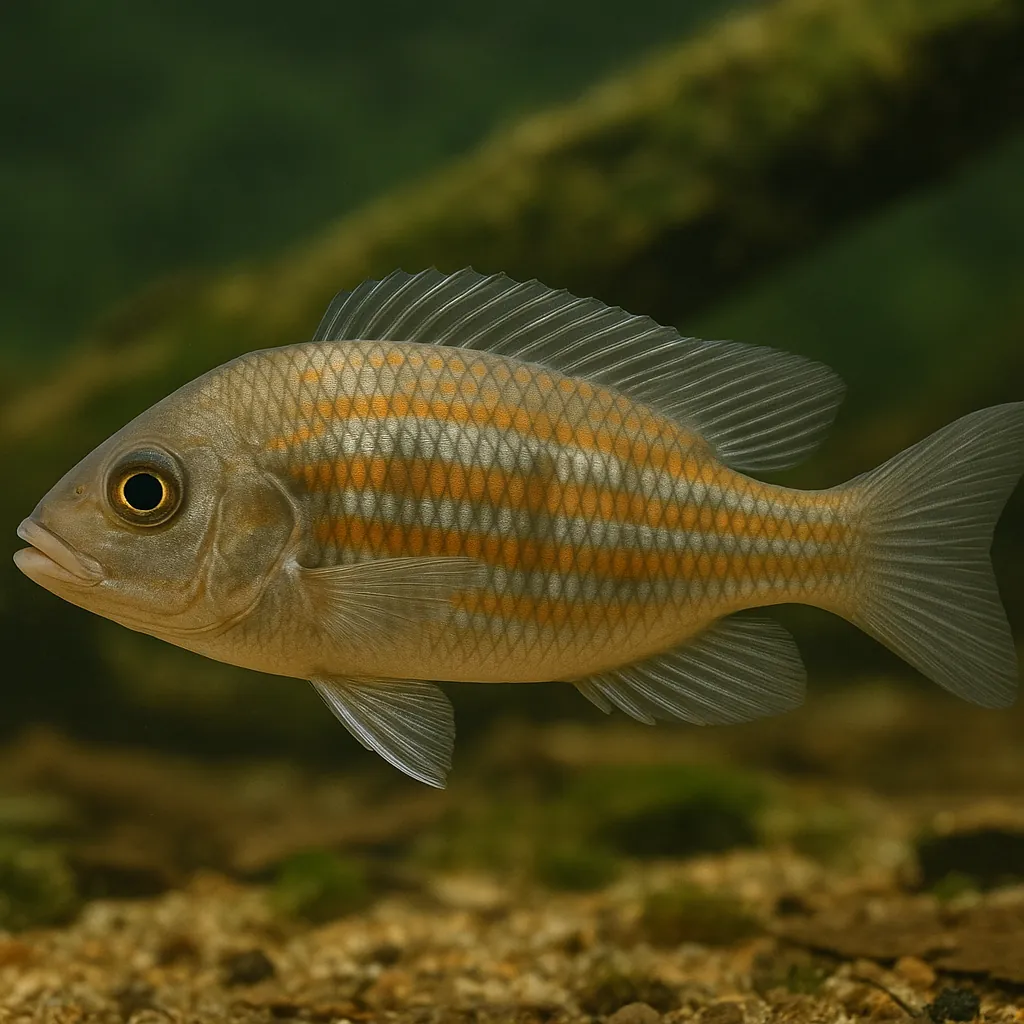
Orangestriped squeaker
Introduction
The Orangestriped Squeaker, scientifically known as Synodontis flavitaeniatus, is a captivating species of upside-down catfish native to the Congo River Basin in Africa. Renowned for its striking appearance, this fish features a brownish or orange-brown body adorned with yellow and dark brown horizontal bands, making it a visually appealing addition to freshwater aquariums. Its unique coloration and intriguing behaviors have made it a favorite among aquarists seeking to diversify their tank inhabitants. While the Orangestriped Squeaker is relatively hardy, it requires specific care to thrive, making it suitable for aquarists with some experience in fishkeeping.
Care and Environment
Providing optimal care for the Orangestriped Squeaker involves replicating its natural habitat and meeting its specific needs.
What is the minimum tank size required for an Orangestriped Squeaker?
A minimum tank size of 115 liters (approximately 30 gallons) is recommended for a single Orangestriped Squeaker. For groups or to provide more space, a larger tank of 200 liters (approximately 50 gallons) or more is ideal.
What are the ideal water parameters for this species?
The Orangestriped Squeaker thrives in water temperatures between 23°C and 28°C (74°F to 82°F), with a pH range of 6.5 to 8.0 and water hardness between 4 to 25 dGH. Maintaining stable water conditions is crucial for their health.
How should the tank be set up to accommodate this fish?
A soft, sandy substrate is ideal to protect their delicate barbels. Incorporate plenty of hiding spots using rocks, caves, and driftwood to mimic their natural environment and provide security. Moderate lighting is preferred, as overly bright conditions can cause stress.
Filtration should be efficient to maintain water quality, but avoid creating strong currents, as this species prefers slow-moving waters. Regular water changes and monitoring of water parameters are essential to prevent the buildup of harmful substances.
In terms of diet, the Orangestriped Squeaker is omnivorous. A balanced diet should include high-quality sinking pellets or wafers, supplemented with live or frozen foods like bloodworms and brine shrimp. Incorporating vegetable matter, such as blanched spinach or zucchini slices, is also beneficial.
Origin and Habitat
The Orangestriped Squeaker is indigenous to the middle Congo River Basin in Africa, including areas like Pool Malebo and the drainages of the Ubangi and Kasai rivers. It inhabits freshwater environments with slow-moving waters, often found in areas with abundant vegetation and submerged structures that provide ample hiding spots. The natural habitat features a soft substrate, typically composed of sand or fine gravel, and experiences tropical temperatures ranging from 23°C to 28°C (74°F to 82°F). Seasonal variations can influence water levels and flow, but the species is adapted to these changes.
Temperament and Compatibility
The Orangestriped Squeaker is generally peaceful and can coexist with a variety of tank mates. However, it's important to consider its behavior and potential size when selecting companions.
Is the Orangestriped Squeaker a shoaling species?
While not strictly a shoaling species, the Orangestriped Squeaker often exhibits gregarious behavior and can be kept in groups. Keeping them in groups of five or more can promote natural behaviors and reduce stress.
What types of tank mates are suitable for this species?
Suitable tank mates include medium to large barbs, characins, adult rainbowfish, non-aggressive cichlids, and other peaceful catfish species. It's advisable to avoid housing them with very small fish that could be perceived as prey or with fin-nipping species that might target their elongated dorsal fin.
How can aggression be minimized in the aquarium?
Providing ample hiding spots and a well-structured environment can help mitigate potential conflicts. Ensuring that all fish have enough space and resources can also reduce territorial behaviors.
Interesting Facts
The Orangestriped Squeaker possesses several intriguing traits that make it a fascinating addition to aquariums.
Why is it called the "Orangestriped Squeaker"?
The name "squeaker" comes from the sound they produce when distressed or handled, a characteristic common among Synodontis species. The "orangestriped" part refers to their distinctive yellow and dark brown horizontal bands.
What unique behaviors does this species exhibit?
Unlike many catfish, the Orangestriped Squeaker is known for its ability to swim upside-down, especially when feeding from the water's surface. This behavior allows them to access food sources that other bottom-dwelling fish might miss.
Is breeding this species in captivity common?
Breeding the Orangestriped Squeaker in captivity is challenging and not widely documented. In their natural habitat, they are believed to spawn during the rainy season, scattering eggs over vegetation and substrate without exhibiting parental care.
Sources
All information in this article has been gathered from the following reputable sources:
Overview
Recommended Tank Size 52.8 Gallons (for groups of 5 or more) |
Minimum Group Size 1 |
Minimum Tank Volume 30.4 Gallons |
Maximum Adult Length 7.7 inches |
Average Adult Length 5.9 inches |
Shoaling (6+ required) No |
Preferred Water Type Freshwater, soft to moderately hard, slightly acidic to neutral |
Temperature Range (°C) 23–28 |
pH Range 6.5–8.0 |
Water Hardness (dGH) 4–25 |
Typical Lifespan (years) 10 years |